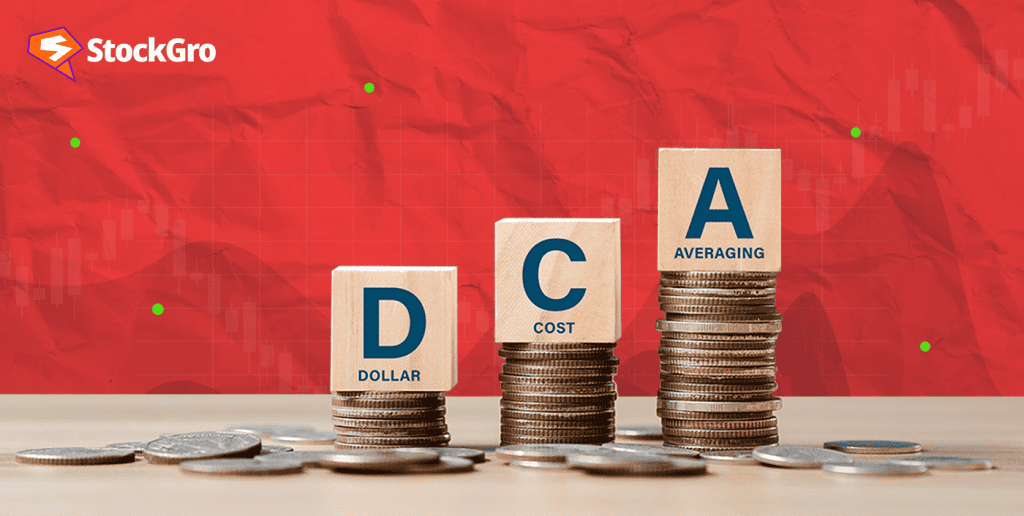
Imagine trying to invest in a stock market downturn. Prices are falling, emotions are running strong, and even the most assured investors may be paralysed by their dread of losing money. Conversely, in a bull market, there is always the desire to rush in at the top in hopes the good days will last a lifetime.
This cycle of ups and downs makes timing the market quite challenging—and, for many, impossible. But if there was a way to invest free from concern about market timing?
Enter dollar cost averaging (DCA), a technique allowing investors to spread their money across time, regularly investing in the market independent of its swings. DCA emphasises slow, consistent contributions rather than trying to predict the ideal time to invest.
The meaning of dollar cost averaging, the ins and outs of what DCA is in the stock market and how it operates will be discussed in this article.
What is dollar cost averaging?
In stock, exchange-traded funds (ETFs), or mutual fund investment, dollar cost averaging is a technique meant to control price swings. This method entails purchasing little sums at regular periods, independent of market performance, instead of a bulk quantity at one particular price.
Investors lower their risk of overpaying when market prices drop following a single significant investment by distributing the acquisition of assets over time.
Making several smaller expenditures enhances the possibility of obtaining a cheaper average cost overall since prices usually vary both up and down. Dollar cost averaging also guarantees that your money is always working for you—a necessary condition for long-term investment development.
How does dollar cost averaging work?
Regardless of market conditions, dollar cost averaging is a basic yet practical investment approach whereby a constant amount of money is committed at regular periods. DCA’s primary goals are to average out the price you pay for an asset over time and reduce the effect of market volatility.
In India, the dollar cost averaging strategy is referred to as rupee cost averaging (RCA). Henceforth, let’s refer to it as RCA.
- Fixed investment: RCA starts with a commitment to periodically, say every month or quarter, a specified amount of money. For example, suppose an investor chooses to monthly invest ₹500 in a mutual fund or stock. Whether the market is growing, declining, or staying level, this sum stays the same.
- Purchasing more units when prices are low: One of the main benefits of RCA is that it lets investors purchase additional units of an asset at low prices. For instance, if the price of the company or mutual fund drops in a given month, the ₹500 will buy more shares or units, therefore optimising your possible returns when the market finally rebounds.
- Purchasing fewer units when prices are high: Conversely, the same ₹500 would buy fewer units as market prices climb. This guarantees that you are not investing all of your money into the market at a peak and helps prevent the overexpression of more expensive assets. This constant buying over time helps the average cost per unit to balance out, therefore reducing the impact of market volatility.
Assume an investor pays ₹2000 every month to invest in a mutual fund over six months; the unit prices change monthly. Rupee cost averaging operates as shown in the table below in this situation:
| Price per Unit (₹) | Investment amount (₹) | Units purchased | |
| Month 1 | 100 | 2,000 | 20.00 |
| Month 2 | 80 | 2,000 | 25.00 |
| Month 3 | 120 | 2,000 | 16.67 |
| Month 4 | 90 | 2,000 | 22.22 |
| Month 5 | 110 | 2,000 | 18.18 |
| Month 6 | 95 | 2,000 | 21.05 |
| Total | 12,000 | 123.12 | |
Now, let’s calculate the average cost per unit:
Average cost per unit=Total investmentTotal units purchased
Average cost per unit=12,000123.1297.47
In this example, despite the fluctuations in the market prices (ranging from ₹80 to ₹120), the average cost per unit over the six months is ₹97.47. This demonstrates how rupee cost averaging helps smooth out the impact of price volatility by consistently investing, allowing the investor to accumulate more units when prices are low and fewer when prices are high.
Advantages of rupee cost averaging
Many investors, especially those trying to accumulate money over time, find rupee cost averaging to be a preferred method for several significant benefits.
- Reduces risk: One of the critical benefits of RCA is its ability to lessen the risk involved with investing significant sums during market highs. Investors can avoid the dangers of making one significant investment at a high price by distributing their funds over time. Since the total investment is less impacted by short-term changes, this strategy reduces the effect of market volatility and guards against abrupt declines.
- Market timing is not required: RCA removes the need to project market movement, which is notoriously difficult even for seasoned buyers. Buyers are not under any pressure to discover the “right” moment to join the market since they routinely commit a specific sum of money. Without having to worry about when to invest, this meticulous approach allows individuals to make money in both rising and declining markets.
- Behavioural advantage: Often driven by fear or greed, emotional investing can result in bad decisions and cause investors to purchase high and sell low. Through a disciplined and methodical investing technique, RCA helps reduce negative emotions. Regular investing schedules help investors stay on track with their goals and prevent hasty decisions motivated by market mood.
- Lowering the average cost: In especially turbulent markets, RCA can significantly lower the average cost of ownership. Investors produce a more favourable average purchase price as they buy fewer units when prices are high and more units when prices are low. Particularly for those who invest in assets subject to regular price swings, this approach can result in notable savings over time.
- Long-term growth: Long-term investors hoping to accumulate riches over time can find RCA very appropriate. Investors can take advantage of compounding returns through regular, even modest investments. These consistent contributions can build up large amounts over time, offering significant growth possibilities and enabling investors to meet their financial objectives.
Also read: How do you stop making emotional money mistakes and invest smarter?
Disadvantages of rupee cost averaging
Although rupee cost averaging has many advantages, one should take into account its restrictions and possible negative consequences. Depending on the state of the market and the financial objectives of the investor, this technique could not always be the ideal one.
- Opportunity cost in rising markets: The opportunity cost RCA creates in a continually rising market is one of its main drawbacks. Under such circumstances, a lump sum investment might beat RCA since the whole amount would gain from the increasing momentum of the market from the beginning. Conversely, investors spread their money over time with RCA, therefore possibly missing out on better profits that would have come from investing all at once when prices were lower.
- Higher transaction costs: RCA also has the disadvantage of perhaps greater transaction expenses. RCA entails regular, smaller investments and, therefore, more transaction fees—especially for equities or mutual funds with commission charges. RCA is less cost-effective than a single significant investment since; for investors with broking accounts that impose hefty trading fees, these expenses can build up and eat into total returns.
- Requires discipline: RCA expects constant discipline from the investor. The approach depends on consistent investments over a defined period; missing contributions may compromise its efficiency. Investors who lack the dedication to make regular investments could completely miss the possible advantages of this approach.
Comparison with lump sum investing
Unlike rupee cost averaging, which spreads investments over time, lump sum investing is putting all available money into the market at once. In a rising market, this strategy might be more successful since early price gains help everyone.
Since lump sum investing takes advantage of price increases, it usually beats RCA in rising markets. RCA can provide greater performance in turbulent or dropping markets, nevertheless, by letting investors purchase at lower prices and, over time, lowering the average cost. RCA is more suited for uncertain or erratic situations since it guards against the risk of investing everything before a market downturn.
Designed for those who would rather lower risk by slow investing, RCA is a safer, more consistent approach. On the other hand, lump sum investing exposes investors to more risks but can yield better profits, particularly if the market drops soon after investment.
Example – Investor B might benefit better when the market rises if Investor A uses RCA and sets away ₹10,000 every month while Investor B sets away ₹1,20,000 all at once. However, Investor A’s slow approach would most likely result in a lower average cost, which reduces risk, should the market swing.
You may also like: Lump Sum Investments in Mutual Funds
Comparison with value averaging
Value averaging (VA) is the technique whereby an investor changes their investment amount depending on the state of the market. Aiming to keep a target portfolio value, VA needs rising contributions when prices fall and lowering them when prices rise, unlike rupee cost averaging, which invests a constant sum consistently.
VA frequently beats RCA in changing markets since it encourages investors to buy more during market declines and less during upswings, so it utilises price movements. Conversely, RCA keeps a constant investment level, smoothing off volatility but not always maximising returns when prices decline.
Although value averaging is more active and complicated and requires continuous portfolio monitoring and changes, capitalising on market declines can yield better returns. Less risk but also less lucrative in some circumstances, RCA presents a simpler, more passive technique with consistent investing without requiring market movement prediction.
Example – If Investor A employs RCA by investing ₹10,000 monthly and Investor B follows VA, changing their investments according to market performance, Investor B might invest more in a dropping market, therefore purchasing more units at reduced rates. Although VA offers better returns, it calls for more discipline and monitoring than the set-it-and-forget-it method of RCA.
Must read: Value averaging
Common mistakes to avoid with rupee cost averaging
Although rupee cost averaging is a good long-term plan, if not properly controlled, some mistakes might result in its failure. These are typical errors to be alert for:
- Inconsistent contributions: RCA is fundamentally based on consistent, set contributions. Ignoring the required investment or missing payments disturbs the efficacy of the plan. Skipping payments during market declines, for example, could cause lost chances to purchase at reduced rates, therefore compromising the advantage of cost averaging. Making this plan successful depends on consistency.
- Ignoring fees: Frequent investments can cause transaction expenses to mount, particularly in markets with high broking fees. Should the transaction fees be substantial, they will eventually reduce your returns. Be aware of these fees and think about avoiding compromising your investing returns by choosing cheap platforms or funds.
- Expecting quick results: RCA is meant for the long run; hence, expecting quick or immediate gains can cause disappointment. Patience is, therefore, quite important since the approach is designed to lower risk and, over time, level out volatility. Short-term gains are not likely to be significant; instead, concentrate on the long-term advantages of persistent investing and compounding.
- Overlooking market trends: RCA lessens the effect of market timing, but it’s still crucial to know more general market patterns. Should the market show notable fluctuations, such as a protracted bull or bear phase, you might have to go over and modify your plan. Following RCA mindlessly without thinking about market fluctuations could either excessively raise risk or limit your benefits.
Bottomline
For individuals looking for a disciplined and quite conservative investment plan, rupee cost averaging is a great method. Regular investments over time help to lower the average purchase price per share and help to reduce the risks connected to market timing.
Though it might not always yield better returns than lump-sum investing, many prefer this approach because of its psychological and financial benefits, which include less market risk and consistent investment practices.
Applying rupee cost averaging helps investors tackle the uncertainty of market investing with more confidence and control.
FAQs
Is dollar-cost averaging risky?
By spreading investments over consistent intervals, dollar-cost averaging lowers the danger of investing a sizable quantity at an inconvenient time. In a rising market, it may result in higher transaction costs and possible opportunity costs even while it reduces market timing risks and emotional investment. Though not totally risk-free, DCA is often less dangerous than lump-sum investment.
Is DCA good for ETF?
Yes, for ETFs dollar-cost averaging works well. By spreading investments over time and purchasing more shares when prices are low and less when prices are high, it lets investors reduce market volatility. But be aware of transaction expenses; these might mount up from regular transactions. Commission-free trading platforms enable one to maximise the advantages of DCA with ETFs.
Is DCA better than lump sum investing?
Through regular investing and psychological comfort, dollar-cost averaging lowers market timing risk by spreading investments over time. In rising markets, lump-sum investing can provide better returns but runs the danger of bad timing. For risk-averse investors, DCA is usually safer; lump-sum investment could be appropriate for those sure in the state of the markets. The best option relies on your risk tolerance and market view.
How do you calculate profit in DCA?
In dollar-cost averaging, find profit by deducting the sum invested from the current value of the investment. To find the overall investment amount, add the cost of every individual purchase. To get the current value, then, multiply the overall number of shares owned by the present share price. Your profit marks the variation between the total investment amount and the present value.
Are DCA and SIP the same?
Though not exactly the same, dollar-cost averaging (DCA) and systematic investment plan (SIP) have similar traits. DCA is a set amount, consistent interval investing approach meant to lower market timing risk. Commonly utilised in mutual funds, SIP is a particular application of DCA whereby investors make regular, automatic payments. Though SIP is a systematic, formalised method, both seek to reduce volatility and encourage disciplined investing.

